- Integrating Ict Into Religioneffective Curriculum Ideas 5th
- Integrating Ict Into Religioneffective Curriculum Ideas 4th Grade
This self-assessment instrument focuses on the routine, everyday integration of ICT use into instruciton, assessment, and student work. Please rate yourself using the following 7-point scale for each question. Why and how are teachers integrating ICT (Information and Communication Technology) into primary education? In this course we analyse examples from schools in different parts of the world, and bring professional teachers, headteachers and policymakers together to share their best ideas and inspiring stories. Now let's look at some examples of integrated lessons. First, for a language arts class, you can use the background for novels or short stories to make an integrated lesson.
Integrating technology into your classroom with the SAMR model
Researching in 2000, Schiller argued that although computers, by this point in history, had been in use in Australian schools for over 15 years “visits to classrooms and principals’ offices indicate that information technology has not yet been integrated into the daily learning activities of the school.” (p.2). Fast-forward ten years and the issue of technology integration was still on the agenda. In 2010, the Federal Government set out its own Digital Strategy for Teachers and School Leaders that aimed to equip educators with the ability to integrate ICT into their educational practices to provide students with the skills that are required for the 21st Century.
Integrating Ict Into Religioneffective Curriculum Ideas 5th
Technology integration does not mean simply teaching basic computer and software skills in the computer laboratory. The mere presence of digital tools in the classroom also does not equate to technology integration. Effective technology integration happens across the curriculum, encourages higher-order creative and critical thinking skills, problem solving, collaboration and results in transformational learning.
What is SAMR?
SAMR is a model designed by Dr. Ruben Puentedura to guide teachers towards effectively infusing technology into their programs. At the Enhancement stage of the model, educators use technology to accomplish traditional tasks. Moving through the model allows teachers to create student-centred, transformational learning experiences that could not be accomplished without the technological tools.
Image the creation of Dr. Ruben Puentedura, Ph.D.
Dr. Puentedura has included Questions and Transitions Ladders to help teachers make the transitions between each level. Does the concept of the SAMR model feel familiar? Here are some excellent links showing the correlation between the SAMR model and Bloom’s Technology.
Kathy Schrock also has a fantastic infographic on the link between SAMR and Bloom’s.
What does SAMR look like in the classroom?
Key Learning Areas: Human Society and Its Environment and English
Unit of Work: Our Fleeting Past

HSIE Outcome: CCS2.1 Describes events and actions related to British colonisation of Australia and assesses changes and consequences.
Language Function: Recounting (for link to English Programming Starter, click here.)
Task: Students research the kinds of people who were on the First Fleet. They then create a historical recount from the different perspectives of those people.
SUBSTITUTION:
After researching the kinds of people on board the First Fleet, students write a historical recount of what the experience was like from one perspective. Students type out their recount using a word processing program, like Word, rather than presenting it in it’s handwritten form. The technology leads to no or little change in the teaching and learning.
AUGMENTATION:

Students enhance their Word document by embedding content and hyperlinks. At this stage, the learning task is not changed but the features of technology are incorporated.
MODIFICATION:
Students work in small groups so that a variety of researched perspectives are represented. Each group has a wiki where they each post their individual Word Documents. Other group members contribute interview questions, via the Wiki, to explore the different perspectives presented. At this stage of the model, technology is modifying the interactions between user and content and between users themselves. Communication, collaboration and contribution are emphasised at this level. The Modification stage allows for a significant functional change in technology use within the classroom.
REDEFINITION:

Students collaboratively film a news piece, taking on the role of the type of person they have researched. News presenters pose some of the questions developed via the Wiki. The final cut of this news piece is uploaded to a school blog and audience members can provide feedback and ask further questions via the Comments section. At this stage, students are doing something that is inconceivable without the technology. They have taken their learning beyond the walls of the classroom and are seeking feedback from an audience beyond their classroom. At this level of the model, learning tasks and technology exist not as ends but as supports for student learning. Here is an example of a news piece created by students researching the people of the First Fleet.
Feeling overwhelmed about how to use the SAMR model in your classroom to ensure effective technology integration? Here is another clip about SAMR- take note of the message at the end about the Redefinition level not being a mountain summit!
&year=2012&publisher=IICBA&TypeOfDocument=UnescoPhysicalDocument&mat=PGD&ct=true&size=512&isPhysical=1&siteId=mainSite)
Do you have examples of Redefined learning tasks that you have been a part of in your classroom?
Further reading

Visit Dr. Puentedura’s blog where he posts many of his presentation slides:http://www.hippasus.com/rrpweblog
Kathy Schrock’s site has a plethora of information on SAMR and some excellent links to SAMR resources.
This wiki has many real-life examples of how the SAMR model can be applied in the classroom.
Integrating Ict Into Religioneffective Curriculum Ideas 4th Grade
DET NSW (2010) Connected Classrooms Program in Action: Compendium, Sydney: Department of Education and Training, http://www.dec.nsw.gov.au/detresources/ccp_in_action_compendium_FNOouLXKim.pdf
Schiller, J. (2000) Implementation of Computing in Schools by Primary Principals: A Longitudinal Perspective, AARE, Sydney
Recent posts:
